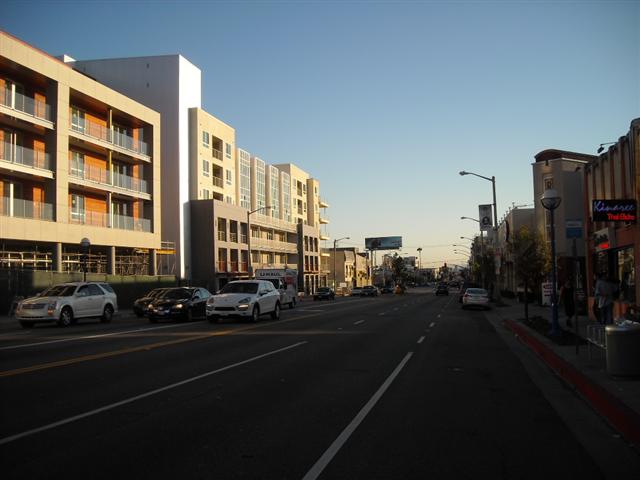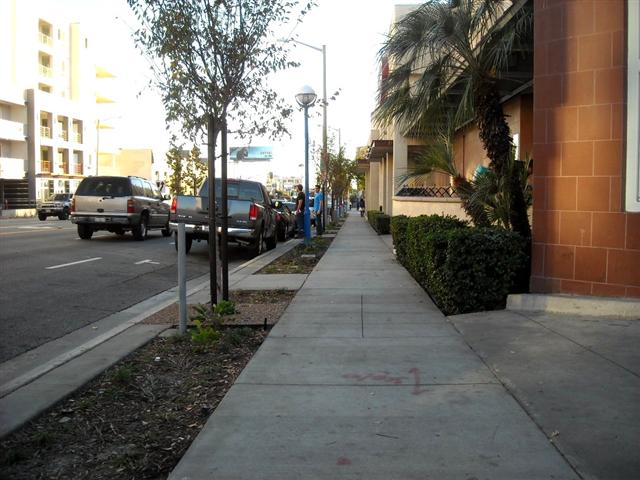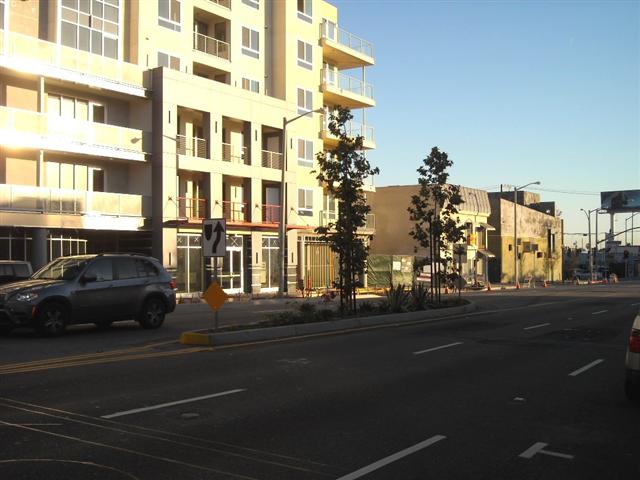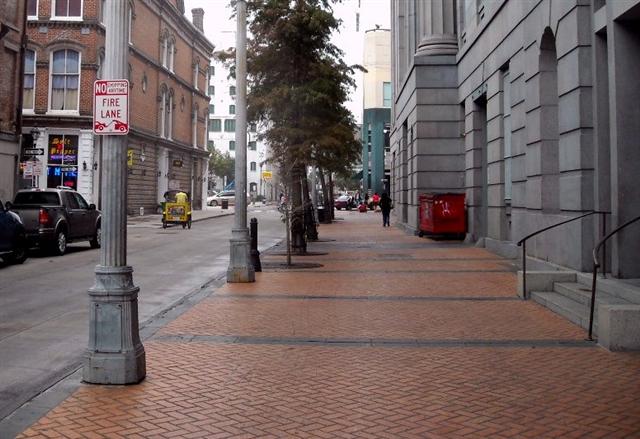
Last year, the city of West Hollywood completed planning for the La Brea Streetscape Project. This ambitious plan includes “design, installation and construction of streetscape improvements to a .375 mile segment of La Brea Avenue in West Hollywood,” as quoted from Metro’s The Source. In addition, the project promised to transform La Brea into a “more complete street that can support more alternative modes of transit”.
This year, the plan started to be put into place. But while La Brea has certainly made a shift towards a “complete street” concept, the goal was still not reached; it seems that the city forgot about bicyclists and didn't do enough for pedestrians.
Which is not to say the project is a bad one. First, here are some good things the project has brought:
- Sidewalks have been repaired, and replaced with fresh layer of concrete & cement;
- New low-level blue streetlights have been installed – to match the existing ones on WeHo’s section of Santa Monica Blvd.;
- Palm trees have been removed, and replaced by drought-resistant deciduous trees;
- Buffer zone – made of fresh lawn and planted trees – has been placed along the sidewalk;
- Several small center-median islands have been built on some portions of the corridor.
Those were noticeable improvements, and we shall thank the city of West Hollywood for them.
However, that’s where the project positives come to a screeching halt. Walking along La Brea is still not appealing, bicycling is outright dangerous, and in the early months since the project was completed, transit usage has not increased.
So if we look at the La Brea Streetscape Project as partially, instead of fully, complete we can see that there are still plenty of opportunities to create a truly complete street. For example:
- Sidewalks: Although repaired and are safer to walk on, sidewalks remain uninviting, due to their naked utilitarian concrete pavement.For example, the Santa Monica & La Brea shopping center – with Best Buy, Target, etc. – offers better walkability. The large plaza, along with sidewalks around the shopping center, has attractive, decorative pavement, with trees and planters. I contacted a West Hollywood representative regarding naked concrete sidewalks on La Brea, but he got overly defensive in response. I then diplomatically explained to him about certain urban guidelines. Plain concrete sidewalks do not attract pedestrians as decorative sidewalks (combined with landscaping) would. At the end, this representative admitted that the cost and complexity of replacing underground utilities are the main reasons why La Brea sidewalks did not get properly paved with decorative covering.
- Streetlights: While the blue “decorative streetlights” were installed – to match the ones on Santa Monica Blvd. – they provide little-to-no improved aesthetics. The new streetlights are too nondescript to truly make a difference. Beautiful historic streetlights were installed on some streets in Hollywood; perhaps WeHo could use the same for La Brea.
- Trees: WeHo did a great job planting deciduous, drought-resistant trees. In some segments more trees could be planted, to fill-in the gaps.
- Buffer Zone and Greenery: This is another area that did not get proper attention. Along the project area there is a new lawn with mostly fresh dirt, but not enough greenery and not a single planter. To compare, the newly completed Fountain & La Brea mixed-use building offers a wider buffer zone with plenty of grass and planters. In fact, it’s mostly the mixed-use development is why La Brea now looks better than ever before.
- Center-Median Islands: The very short islands provide little-to-no improvement. True, having short islands is better than none at all, but they could have been much larger. The nearby Highland Avenue, for example, has gone through a much more dramatic transformation thanks to much longer and wider center-medians. City of WeHo claims they tried to accommodate left-turn pocket lanes. However, in reality the number of cars using left-turn pockets is insignificant to justify very short center islands. Some of the “precious” left-turn car space could, after all, be sacrificed to lengthening the center-median islands – to improve streetscape on La Brea.
- Bicycle Facilities: This is where City of West Hollywood deserves a 5-star Failure rating! Not a single bicycle facility has been provided for the entire La Brea Streetscape project. WeHo simply ignored all the pleas and requests from the public, and provided zero Bike Lanes, or even Sharrows. As far as bike parking, I only saw one (!) new rack installed – that’s for the entire project.
- Other Modes of Transit: The plan openly stated to include “more alternative modes of transit”, however nothing of this sort was done. All bus stops and other amenities remain the same. La Brea Avenue remains primarily a car-obsessed corridor, just as it always did.
- Complete Street (or Not): The existing 6 lanes on La Brea should have even been reduced to 4 lanes. This would accommodate: (a) wider center-median with plenty of trees & greenery, (b) wider sidewalks and buffer zone, and (c) Class II bike lanes. This change would have made La Brea a truly “Complete Street”. Sadly, none of this has materialized. La Brea remains a dangerous 6-lane highway with no room for safe bicycling, and barely any improvements for pedestrians.
What conclusions can we draw?
La Brea Streetscape project did improve the appearance of the boulevard, but many aspects have been neglected. The project was obviously completed on a low budget and tight schedule. Much more could have been done – to improve the appearance and quality of life along La Brea Avenue. Unfortunately, City of WeHo demonstrated its car-only mentality, with barely any improvement for pedestrians, transit users, and especially bicyclists.
Thankfully, two large La Brea mixed-use developments – one at Fountain, and the other at Santa Monica Blvd – have significantly beautified the area. The nearly-completed buildings look beautiful, modern, and even have some architectural appeal (more could be added, though). Increased density, combined with better walkability and safer environment – should play a positive role for the area. Quality of life is all but certain to improve.
Now, let’s refer to some photos that I recently took to show how La Brea has improved and can be further improved.









Now, let’s take a look at other examples. Recently I visited New Orleans, LA, and was amazed at the city’s walkability! Below you can find examples of how beautiful the streets, and sidewalks, can look when truly pedestrian-friendly streetscapes are installed. This can be a good lesson for city of WeHo.






To summarize: L.A. County in general, and West Hollywood in particular, have yet to learn from other cities in the U.S. (let alone other countries) what proper urban design truly is, and what street aesthetics are about. La Brea Avenue offers anything but proper urban design. True, vastly propagated “car culture” has taken away walkability and streetscape.
Nevertheless, our cities should attempt to reinstate our pedestrian infrastructure and provide the most essential urban design guidelines, as it is done in the rest of the world. Unfortunately, our city officials continue to let things drift on their own, leaving it up to the private developers to beautify selected street segments. Hence our city streetscape is improving at a snail’s pace. Thankfully, most large projects do include street beautification and transformation; both La Brea mixed-use projects are a good example.
I still hope, pedestrian features (better sidewalks, more trees and planters, and a wider buffer zone) and bicycle infrastructure (bike lanes and plenty of bike parking) will be added to La Brea and other major corridors in the near future. It’s time for our local governments to embrace sustainability, and to provide streets for everyone, not just for cars. After all, that’s the reason the “Complete Streets” act was approved.






